Table of Contents
App Gamification!
This is a concept that has been trending in mobile app development industry and rightfully so. Wondering why? Let us show yoy:
Today, the global gamification market is worth more than $11.94 Billion. Reason being that, App Gamificationhas helped various platform improve their engagement by 48%.
In fact, when it comes to retail apps and web platform, gamification resulted in 700% increase in customer acquisitions.
And this has caused a lot of businesses and already platforms from across the world to gamify their app. If you are one of them, this blog is for you.
Here, we shall be discussing all you need to know about App Gamification, top examples, benefits, how to create a strategy, and more.
What is App Gamification?
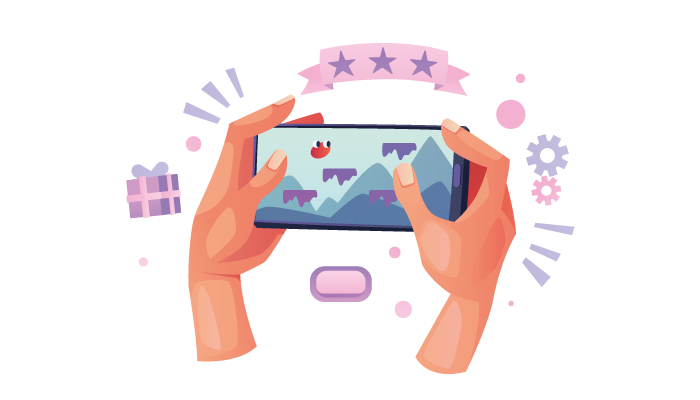
A lot of people are asking, what is app gamification?
App Gamification refers to the practice of incorporating game elements and mechanics into a mobile application to enhance user engagement and motivation.
It leverages the principles of game design to make the app more enjoyable, interactive, and rewarding for users. By integrating gamification techniques, mobile app developers aim to increase user participation, promote specific behaviours, and drive desired actions within the app.
Moreover, the game elements used in App Gamification can include points, badges, levels, leaderboards, challenges, rewards, virtual currencies, and progress tracking.
These elements are strategically implemented to create a sense of achievement, competition, and progression, mimicking the experience of playing a game.
Users are encouraged to complete tasks, overcome challenges, and earn rewards, which can enhance their overall experience and provide a sense of accomplishment.
You see, the concept of gamifying an app is so influential that a lot of businesses are willing to redesign the app. And this gets you wondering what are benefits of App Gamification?.
Benefits of App Gamification
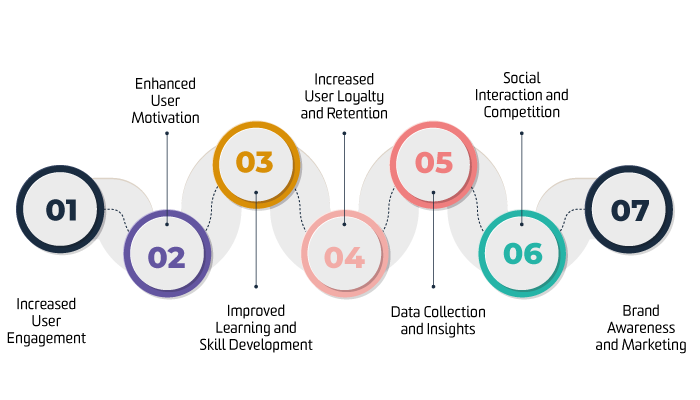
Are you wondering why a lot of people want to gamify app? well, there are a lot of mobile app gamification benefits.
Therefore, let’s look at some of the top benefits and reason to gamify an app. These are, as mentioned below:
Increased User Engagement
One of the first big reason is improvement user engagement,
You see, the app gamification techniques, such as points, badges, leaderboards, and challenges, motivate users to actively participate in the app.
By adding a competitive or collaborative element, users are encouraged to spend more time interacting with the app and its features.
Enhanced User Motivation
We all know that, games are inherently designed to be engaging and motivating. By integrating game-like elements, mobile apps can tap into the intrinsic motivation of users.
Moreover, rewards, achievements, and progress tracking can provide a sense of accomplishment and drive users to continue using the app.
Improved Learning and Skill Development
One of the most common and important use of gamification is on eLearning App Development. App gamification can be particularly effective in educational or skill-building apps.
By transforming learning activities into interactive games, users can have a more enjoyable and immersive learning experience.
Game mechanics like challenges, levels, and rewards can promote learning retention and skill development.
Increased User Loyalty and Retention
Loyalty is a value much revered in the world of retail and business as whole.
And app gamification can help create a sense of loyalty and attachment to the app.
By providing users with rewards, recognition, and a sense of progression, they are more likely to remain engaged and continue using the app over an extended period.
Therefore, this can lead to higher user retention rates.
Data Collection and Insights
With the big data becoming such a thing, collecting data has become more important than ever.
Gamification techniques often collect valuable data about user behavior, preferences, and performance.
This data can be used to gain insights into user engagement patterns, identify areas for improvement, and personalize the app experience.
It allows app developers to make data-driven decisions and enhance user satisfaction.
Social Interaction and Competition
It goes without saying that gamified apps can foster social interaction and healthy competition among users.
Leaderboards and multiplayer features encourage users to compare their performance with others, engage in friendly competition, and share their achievements.
This social aspect can increase user engagement and create a sense of community within the app.
Brand Awareness and Marketing
Whether it is corporate branding or any other kind of market, Gamified apps can be a powerful tool.
By integrating elements like branded content, rewards, or sponsored challenges, companies can increase brand awareness, engage with their target audience, and create a memorable brand experience.
So, these are the top benefits of mobile app gamification. And with this out of the way, let’s look at essential.
App Gamification 5 Essential Elements
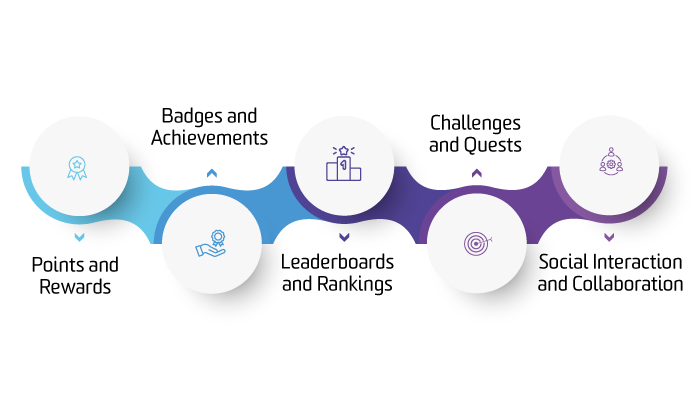
What are essential elements of app gamification?
Well, we shall be discussing all you need to know about the same in this section of the blog. These are, as mentioned below:
Points and Rewards
Points and rewards are one of the fundamental elements of app gamification.
Users earn points for completing specific actions or achieving certain milestones within the app. These points can then be used to unlock rewards, such as in-app bonuses, virtual goods, or exclusive content.
The sense of progression and the anticipation of earning rewards motivate users to continue using the app and complete desired actions.
Badges and Achievements
Badges and achievements are visual representations of a user’s accomplishments or milestones within the app.
They are awarded when users reach specific goals, complete certain tasks, or demonstrate expertise in a particular area.
Badges and achievements provide a sense of accomplishment, status, and recognition, fostering a feeling of competitiveness and encouraging users to explore different aspects of the app.
Leaderboards and Rankings
Leaderboards display the rankings and scores of users, allowing them to compare their performance with others. They create a sense of competition and social interaction among users.
Leaderboards can be global, showing the top performers across all users, or segmented by friends or groups to encourage friendly competition.
By displaying rankings, users are motivated to improve their performance and strive for higher positions on the leaderboard.
Challenges and Quests
Challenges and quests introduce specific tasks or objectives for users to complete within the app. These tasks can range from simple daily challenges to more complex and time-limited quests.
By providing a clear goal and a sense of purpose, challenges and quests drive engagement and motivate users to actively participate in app activities.
They can also be designed with increasing difficulty levels or progressive rewards to maintain user interest and provide a feeling of accomplishment upon completion.
Social Interaction and Collaboration
Social interaction and collaboration features allow users to connect with each other, share their achievements, and collaborate on tasks.
These features can include chat functionality, social media integration, or multiplayer capabilities.
By fostering a sense of community and enabling users to interact and engage with others, the app becomes more social and immersive.
Users can compete, cooperate, or simply share their experiences, enhancing the overall gamification experience.
App Gamification Examples
What does gamification teach us? It tells us people learn better passively and when they are having fun.
And we are applying the same concept to this concept, teaching you concept of gamification with examples. Therefore, let’s look at mobile app gamification examples.
These are, as mentioned below:
Duolingo
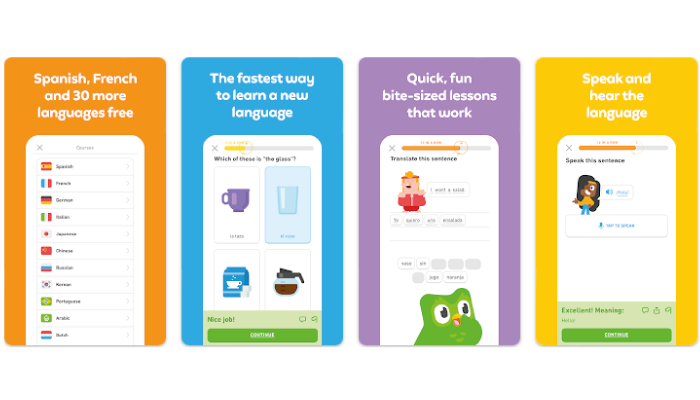
We have all heard of Duolingo.
It is a language-learning app that incorporates gamification to make the learning process more engaging.
Coming to gamification part, it uses levels, achievements, streaks, and a leaderboard to encourage users to complete daily lessons, earn points, and compete with friends.
The app’s design resembles a game, with colorful graphics and a sense of progression.
Habitica
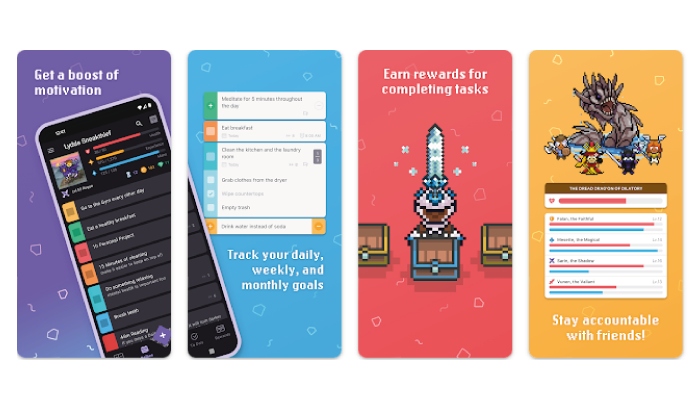
Another popular app on the list is this productivity platform.
Habitica transforms your daily tasks and habits into a role-playing game. Users create their avatars and gain experience points by completing real-life tasks and developing positive habits.
Moreover, they can also join parties and go on quests with friends, making productivity a fun and collaborative experience.
Nike+ Run Club
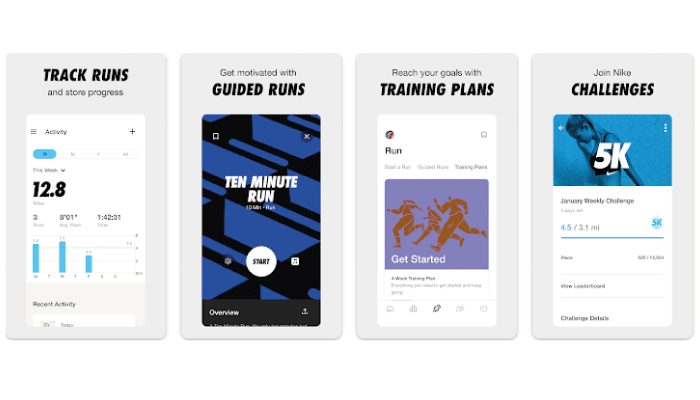
This running app adds app gamification elements to motivate users to stay active and achieve their fitness goals.
It offers challenges, achievements, and personalized coaching plans. Users can earn badges for milestones, beat their personal records, and compare their performance with the global community, fostering a sense of competition and accomplishment.
As such, it is an excellent example of gamification in fitness app development.
Zombies, Run!
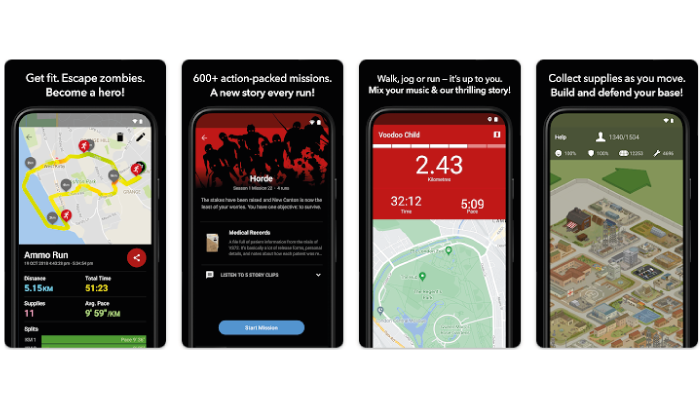
Here’s another fitness app gamification example.
Zombies, Run! combines storytelling and fitness tracking in an immersive audio adventure game. As users go for a run, they listen to a story where they are survivors in a post-apocalyptic world.
The app simulates a zombie chase, prompting users to increase their pace to avoid being caught. Completing missions and collecting supplies within the game adds an extra layer of motivation.
These are some of the best gamification apps. And with this out of the way, let’s see how you can create app gamification strategy.
How To Create App Gamification Strategy
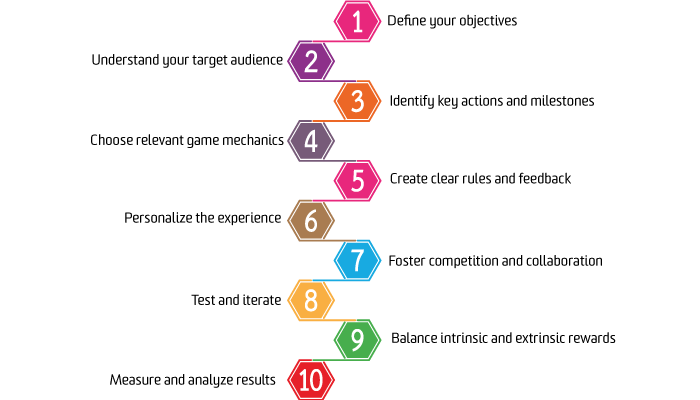
So how do you gamify app?
Well, to make app gamification happen, you need to create a strategy. Now, how do you create app gamification strategy?
We have got you covered. Let’s discus the entire step by step process in detail below:
1. Define your objectives
Determine the specific goals you want to achieve through gamification.
Are you aiming to increase user retention, drive engagement, encourage social interaction, or promote certain behaviors?
Clearly defining your objectives will guide your gamification efforts.
2. Understand your target audience
Gain insights into your target audience’s preferences, motivations, and behaviors. Consider factors like demographics, interests, and their existing engagement with similar apps or games.
This knowledge will help you design gamification elements that resonate with your users.
3. Identify key actions and milestones
It is very important to identify the key actions or milestones users need to complete within your app. These can be tasks, achievements, levels, or any other meaningful actions.
Break down the user journey and determine where app gamification elements can be incorporated to make these actions more engaging.
4. Choose relevant game mechanics
Select game mechanics that align with your app’s purpose and user goals.
Some common mechanics include points, badges, levels, leaderboards, challenges, virtual currency, rewards, progress bars, and social interactions.
Moreover, you should also consider how these mechanics can be integrated seamlessly into your app’s features and functionalities.
5. Create clear rules and feedback
Ensure that the rules and mechanics of your gamification elements are easy to understand and follow.
Users should know what they need to do, how to earn points or rewards, and how their progress is measured. Provide timely and meaningful feedback to users to reinforce their actions and motivate further engagement.
6. Personalize the experience
Tailor the app gamification elements to individual users whenever possible. Use data-driven insights to provide personalized challenges, recommendations, or rewards based on user preferences, past behaviors, or performance.
It goes without saying that, personalization enhances engagement and makes the experience more relevant to each user.
7. Foster competition and collaboration
Incorporate social elements to encourage competition and collaboration among users.
Leaderboards, achievements, challenges, and social sharing features can drive engagement as users strive to outperform others or work together towards common goals.
And provide opportunities for users to connect, communicate, and interact within the app.
8. Test and iterate
Implement the app gamification elements in your app and closely monitor user engagement and behavior.
Then collect feedback, analyze data, and make iterative improvements based on user responses. Continuously refine your gamification strategy to optimize its effectiveness and address any shortcomings.
9. Balance intrinsic and extrinsic rewards
Strike a balance between intrinsic motivation (the inherent enjoyment users derive from the app experience) and extrinsic rewards (tangible incentives like points, badges, or discounts).
While rewards can be powerful motivators, relying solely on external rewards may undermine intrinsic motivation in the long run. Find the right mix to sustain engagement.
10. Measure and analyze results
Define key performance indicators (KPIs) to measure the success of your gamification strategy.
Metrics like user retention, time spent in the app, completion rates, social interactions, and conversion rates can provide valuable insights.
Analyze the data to evaluate the effectiveness of your gamification efforts and make data-driven decisions for future iterations. This step is quite similar to what we do in app optimization.
5 Gamification Mistakes to Avoid
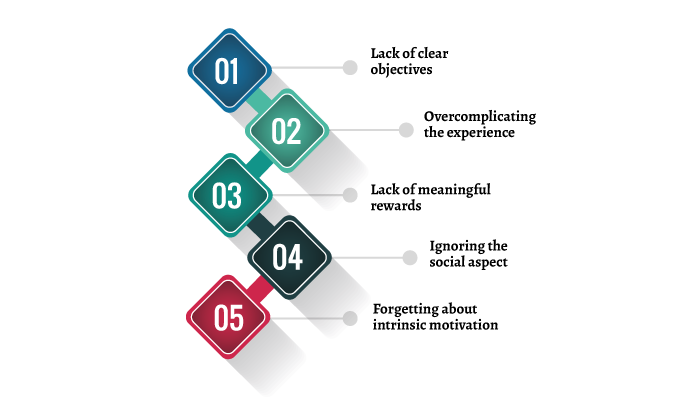
It’s easy to make mistakes in mobile app development and same is the case with app gamification process.
So, to save you the pain of learning from your own mistakes, here are some common app gamification mistakes that you should avoid.
Lack of clear objectives
One of the biggest mistakes in app gamification is not defining clear objectives. Before implementing gamification elements, you should have a clear understanding of what you want to achieve.
Whether it’s increasing user engagement, driving specific behaviors, or improving learning outcomes, having well-defined goals helps you design appropriate mechanics and incentives.
Overcomplicating the experience
App gamification should be intuitive and easy to understand. Avoid making the experience overly complex or convoluted, as it can confuse users and lead to disengagement.
Moreover, you should keep the mechanics and rules simple, ensuring that users can easily grasp how the game elements relate to their actions and goals.
Lack of meaningful rewards
Rewards are a key element of gamification, but they need to be meaningful and aligned with users’ motivations.
Developers should also avoid offering rewards that are trivial or disconnected from the desired behaviors. Instead, provide incentives that are valuable to your users and directly tied to the objectives you want to achieve. This could be in the form of virtual currency, levels or badges, access to exclusive content, or real-world rewards.
Ignoring the social aspect
Humans are social beings, and incorporating social interactions into app gamification can significantly enhance the experience.
So, it’s very helpful to avoid neglecting the social aspect by failing to include features such as leaderboards, multiplayer options, or collaborative challenges.
Therefore, social elements can foster healthy competition, encourage collaboration, and tap into users’ desire for recognition and status.
Forgetting about intrinsic motivation
While extrinsic rewards are essential in app gamification, it’s crucial not to overlook intrinsic motivation. Intrinsic motivation refers to the internal desire and satisfaction that come from engaging in an activity itself.
App gamification should tap into users’ intrinsic motivation by making the experience enjoyable, providing meaningful challenges, and fostering a sense of mastery and autonomy. Balancing extrinsic rewards with intrinsic motivation ensures a more sustainable and engaging app gamification design.
Conclusion
This is all you need to know about app gamification. Now, if you are someone who wants to apply it in your app or want to learn more about the same, it’s highly recommended that you consult an app development & designing company.
FAQ
Gamification can help mobile apps increase user engagement, retention, and conversion. It can also help apps make their onboarding process more effective and enjoyable.
Common gamification elements include points, badges, levels, leaderboards, challenges, and rewards. These elements can be used to track progress, provide feedback, and motivate users to keep using the app.
The right gamification elements for your app will depend on your specific goals and audience. However, some general tips include:
- Choose elements relevant to app’s content and goals.
- Make sure the elements are easy to understand and use.
- Keep the elements simple and unobtrusive.
There are a number of ways to implement gamification in your app. You can use a third-party gamification platform, or you can build your own gamification features from scratch.
Some common mistakes to avoid when gamifying a mobile app include:
- Overusing gamification elements.
- Making the gamification too complicated or difficult to understand.
- Not providing clear goals or rewards.
Some best practices for gamifying a mobile app include:
- Keep the gamification simple and unobtrusive.
- Make sure the gamification is relevant to your app’s content and goals.
- Provide clear goals and rewards.
- Track user progress and feedback.
Some examples of successful mobile apps that use gamification include:
- Duolingo: A language learning app that uses points, badges, and levels to motivate users to learn new languages.
- MyFitnessPal: A fitness tracking app that uses challenges, streaks, and rewards to help users stay motivated.
- 2048: A puzzle game that uses simple yet addictive gameplay to keep users engaged.
The future trends in App Gamificationare likely to focus on making gamification more personalized and engaging. This could involve using artificial intelligence to track user behavior and preferences, or using augmented reality to create more immersive experiences.





No Comments
Comments are closed.